Editor’s Note: The following is a post by Mark Kakkuri, a nationally published freelance writer who covers guns and gear, 2nd Amendment issues and the outdoors. His writing and photography have appeared in many firearms-related publications, including the USCCA’s Concealed Carry Magazine. You can follow him on Twitter @markkakkuri.
Read Mark’s previous articles in this “Top Five” series:
- Top Five Everyday Carry Gun Belts
- Top Five Newer Guns I Recommend You Try
- And Top Five Deep Cover Carry Options
- Top Five Pieces of Everyday Carry Gear to Give Away (and Get) in 2018
- Top Five Handgun Accessories
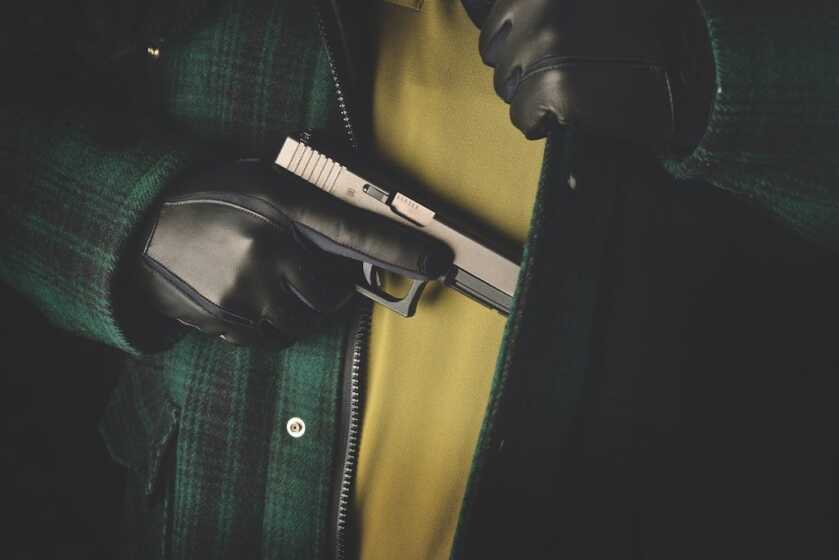
In my neck of the woods, we just enjoyed a night where the temperature reached 15 degrees below zero Fahrenheit. This wasn’t with wind chill or the “real feel” or “feels like” temperature. It was the actual temperature. There are places in the nation that were colder, yes. But at some point on the thermometer, it didn’t matter if it was 10 degrees, 0 degrees or -10 degrees. It was just cold. The kind of cold that hurts your face. The kind of cold that is dangerous if you’re not dressed appropriately.
The weekend of the extreme cold coincided with a group retreat at an up-north camp known for its tubing, skiing, skating, hockey and other outdoor activities. The high temperature for the weekend was 2. And, yes, we would be spending the majority of our time outside.
I agree with whoever said, “There’s no such thing as bad weather; there’s only bad clothing.” The point is that you can dress or gear up for just about any kind of weather, including extreme cold, for a certain amount of time. So I dressed accordingly and brought some outdoor cold-weather gear with me just in case. I packed an always-with-me backpack. Not so much to survive outside for days on end, but to handle some basic needs and to be a resource for those around me in case there were any problems. And, of course, I had my knife and gun with me. With that, here are my top five (actually, six) pieces of cold-weather gear. Three of them dedicated to creating and retaining heat.
1. Extra Coat
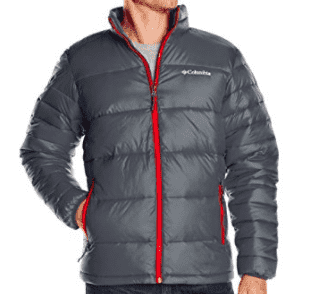 Stuffed into the main compartment of my backpack was a thin, down-filled jacket. This would add a useful extra layer if the temperature just got to be too much for me or anyone else. Someday, I’ll look at the top five the fabrics available to us today — from synthetics to natural fibers, from polar fleece to wool.
Stuffed into the main compartment of my backpack was a thin, down-filled jacket. This would add a useful extra layer if the temperature just got to be too much for me or anyone else. Someday, I’ll look at the top five the fabrics available to us today — from synthetics to natural fibers, from polar fleece to wool.
I was already wearing technical fabrics and a layer of wool under a Woolrich-quilted winter coat with a waxed-canvas shell and a sherpa-lined hood. But I wanted to have this easily packable layer available too. Other options could include a fleece jacket or a wool blanket. But down is a terrific insulator and, in this form, hardly takes up any room at all.
2. Water
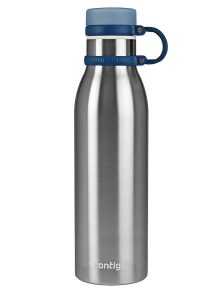 Being outdoors, even in extreme cold, requires exertion, and perspiration still occurs. So the need for adequate hydration continues, just like it does in more agreeable weather.
Being outdoors, even in extreme cold, requires exertion, and perspiration still occurs. So the need for adequate hydration continues, just like it does in more agreeable weather.
In my weekend travels, I carried a single Contigo Thermalock 20-ounce bottle with cold water. This would be mainly for my own hydration. But I could carry hot water — and it would stay hot for 10 hours — if I wanted to.
I had no notions of making soup or coffee while out in the cold, but if I were adding a serious hike or not returning to camp lodging for several hours, I’d consider these options. Some survival kits include small bags of drinking water that pack easily and will keep for a long time.
3. Space Blankets
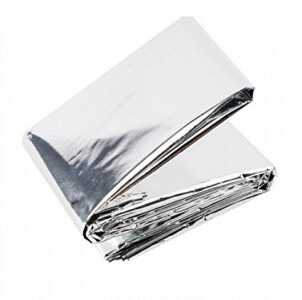 On the possibility that one of our group injured themselves, becoming immobile or unmoveable, a space blanket could serve several purposes. Of course, I could wrap someone in the foil-like blanket, helping him or her to retain their own body heat. Or, if we built a fire nearby, we could use the space blanket to reflect some of the heat toward the person.
On the possibility that one of our group injured themselves, becoming immobile or unmoveable, a space blanket could serve several purposes. Of course, I could wrap someone in the foil-like blanket, helping him or her to retain their own body heat. Or, if we built a fire nearby, we could use the space blanket to reflect some of the heat toward the person.
A space blanket can also serve as a giant reflector, helping search parties find a person in trouble. Or it can serve as a tarp to create some kind of temporary shelter or to collect rainwater or snow for a source of water. Rather than figuring out how to use one, I simply carried two. When folded, they hardly take up any space.
4. Hand-Warmer Packets
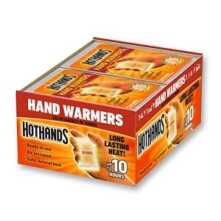 Available to be purchased by the case, a set of these should be in every jacket, every vehicle and every bag or backpack. Nine times out of 10, they’ll be used to warm hands or toes, but several of them used at once inside a space blanket can provide a few hours of critical warmth.
Available to be purchased by the case, a set of these should be in every jacket, every vehicle and every bag or backpack. Nine times out of 10, they’ll be used to warm hands or toes, but several of them used at once inside a space blanket can provide a few hours of critical warmth.
Some winter gloves even come with zippered compartments for hand warmers, and I’ve seen people tuck them into their boots and under their beanies to bring warmth. Activated by exposing the chemicals to air, hand warmers are easily portable and last a long time inside a protective plastic pouch until needed.
5. Flashlight
 It should go without saying that a flashlight should be a part of your EDC, but I’ll say it again anyway. For this trip, I carried a small tactical flashlight in my pants pocket as well as extra AA batteries. I made it a point to keep the light and batteries in a pocket where they would benefit from being as close to my body as possible in order for them not to get too cold.
It should go without saying that a flashlight should be a part of your EDC, but I’ll say it again anyway. For this trip, I carried a small tactical flashlight in my pants pocket as well as extra AA batteries. I made it a point to keep the light and batteries in a pocket where they would benefit from being as close to my body as possible in order for them not to get too cold.
Actually, I had two backup flashlights in my backpack — something I could give to someone else if an urgent situation that required more than one person to handle arose. With a flashlight you, of course, have not only the means to see when it’s dark but also to be able to signal a search party and be seen. One of the flashlights had a setting which would set the flash pattern in the universally recognized SOS pattern.
Bonus: Fire Starter, Tinder, Flint and Steel, Waterproof Matches and Candle
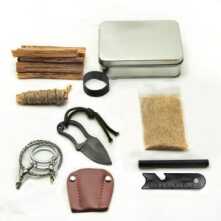 All packed into a tidy survival tin, these fire-making essentials provided me with numerous ways to ignite a fire to create heat and light. I could have gone with just the matches or just the flint and steel, but I opted to double up in case one ran out, one got lost or someone else needed a means to start a fire.
All packed into a tidy survival tin, these fire-making essentials provided me with numerous ways to ignite a fire to create heat and light. I could have gone with just the matches or just the flint and steel, but I opted to double up in case one ran out, one got lost or someone else needed a means to start a fire.
We’re talking about gear that takes up about as much space as a wallet, so it was no trouble to carry these extras. I just wanted to be absolutely certain I could start a fire if needed. As for fuel, we were in a forest so there was no shortage of sticks.
Your turn: What do you like to carry for handling the cold weather?
Editor’s note II: All product photos in this article come courtesy of Amazon.com. The product links go to Amazon as well. Just FYI. GunsAmerica has no affiliation with Amazon.com. In fact, if you know a better place to buy cool, cold-weather gear, feel free to chime in below. Jeff Bezos has plenty of money as it is and I wouldn’t mind sharing the wealth with some mom-and-pop retailers.
***Shop for Your New Handgun on GunsAmerica***
Discover how you can join more than 200,000 responsibly armed Americans who already rely on the USCCA to protect their families, futures and freedoms: USCCA.com/gunsamerica.

The thing I saw left out that I consider absolutely essential for cold weather is U.S. Army Micky Mouse, cold weather boots. I do not believe that it gets so cold in the continental U.S. to where they are not sufficient.
Nice article, but you missed the most important item.. a compass. It will keep you from a situation where you might need all the other stuff. I take many U.P. winter wilderness walks and besides my trusty .223 levergun, its a small led flashlight, a lighter and always a compass when the days are short and the snow is deep.
Good list.
I have been on over 100 winter, mountain river WW kayak trips in the East so I have some experience being cold and wet.
I don’t do it anymore but learned some things. I shoot competition guns now.
Down – Best insulation, Packs small, light – BUT – Be sure you have rain cover. If Down gets wet you/it are DONE.
Fire Starter Kit – Absolutely, good kit.
ADD
MITTENS, TOBOGGAN, XTRA BATT, BIC LIGHTER, CANDLE, ZIPLOC BAGS
MITTENS – If your hands don’t work, nothing gets done.
Wool Army Surplus. At 70yo old I can attest that – your fingers get colder faster when you are older.
I Pack a pair of mittens, large enough to put a gloved hand into. The old wool surplus Army kind.
Shooter mittens with a right hand open slot. Cheap, don’t take up much room.
Can shoot, make fire, etc, if needed, w/o removing whole mitten.
Hand warmers good but only last a few hours. Most competition shooters use them at matches.
TOBOGGAN/wool. 90% heat lost thru head?
BATTERY – Extra flashlight batt. Cold is hard on batts. Or carry light next to body.
CAP LIGHT – With small mounted bill light, “Very” handy. I now wear one “everywhere”.
BIC LIGHTER – Very handy, works ok down to say 10 below. Take 2,3. Keep in a Zip Loc Bag.
CANDLE – Small Light and heat source(For fingers). Can be life saver – how do I know:)
Even the small, flat Fondu kind better then nothing.
SPACE BLANKET – Good but limited, light, compact but tears and wind blows easy.
Rip-Stop Space Blanket – Much Better – if you can – the Rip-Stop kind. Heavier, bulky but well(life saver) worth it.
Can also be used as rain shelter, ground cloth, more. Take both.
WOOL – Much Heavier but usually still works when wet.
I usually wore a wet-suit and often slept in it including gloves and booties.
Zip Loc bags – Take a few. The need, when it comes, will be apparent.
Pretty good list except for the space blanket. Once they get a tear they come completely apart. Your better off getting contractor grade trash bags like they use to pick up garbage along the freeway, they are much stronger. There’s just better stuff out there that space blanket junk…
Apart from the fact you’ll sweat like a hooded rapist sleeping in a bin bag.